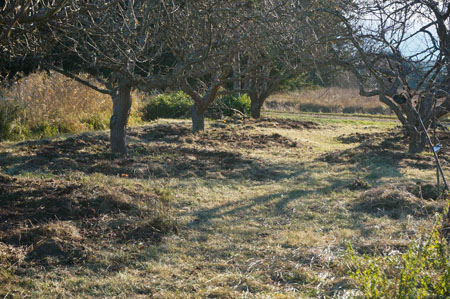 We have this old orchard on our homestead – how old is anybody’s guess. The house is over 100 years, so perhaps the trees are as well? How long do they live? It comprises 9 trees (apples, pie cherries, and an Italian prune), and despite its age, produces more than we can use, but not really enough for any kind of commercial enterprise.
We have this old orchard on our homestead – how old is anybody’s guess. The house is over 100 years, so perhaps the trees are as well? How long do they live? It comprises 9 trees (apples, pie cherries, and an Italian prune), and despite its age, produces more than we can use, but not really enough for any kind of commercial enterprise.
The trees, like a lot of neglected orchards, are fraught with a tangle of suckers and twisted branches growing contrary to common sense. Gradually we have been pruning them back into shape, opening the centers to more light, and mowing the grass around and around. We are not ones to spray copper, sulfur, and assorted pesticides; nor have we added any fertilizers. In fact, we have rarely even watered them (they have obviously survived quite well on their own thus far, being situated alongside an irrigation ditch). It has been a learning process for us, too, and sometimes there is only so much you can do. The apples have a lot of scab. Pill bugs and earwigs enjoy them a lot. I think 4 of them are heirloom Gravensteins. They taste great.
And then one day, in reading Michael Phillips’ “The Holistic Orchard – Tree Fruits and Berries the Biological Way,” I began to realize that the typical orchard, planted in rows and surrounded by grass, produces in spite of the conditions we put them in. The descriptions were painfully familiar. It struck me that with a little help, this orchard could be so much more. Toby Hemenway’s book, “Gaia’s Garden,” was another eye-opener. Obviously, there are simple things we can all do to work with Nature, rather than against her.
Thus began the mission to let Nature “reclaim” the orchard.
